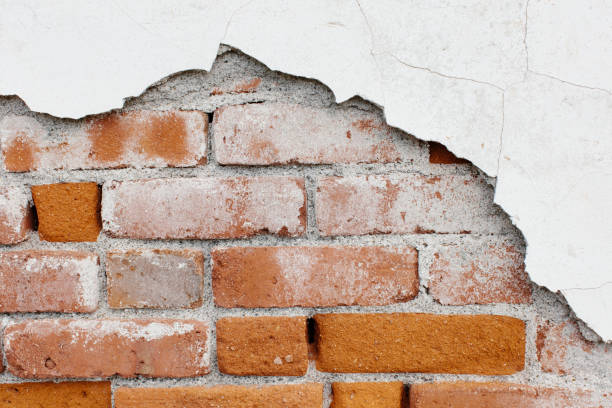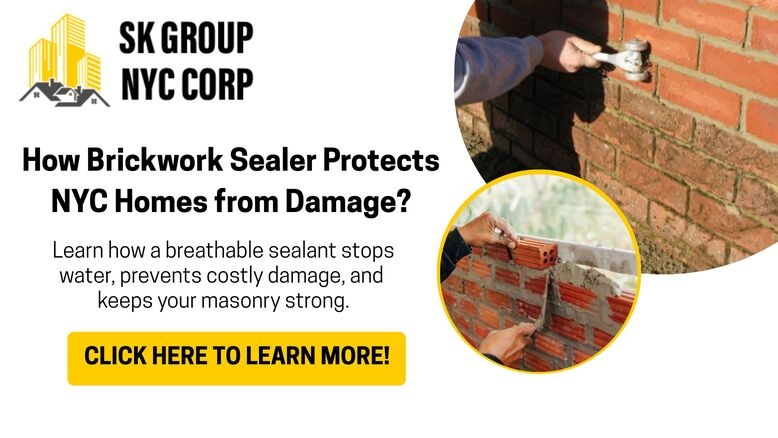If you own a piece of the Big Apple from a historic brownstone to a classic pre-war co-op you know the unique challenges of maintaining an NYC home. The city’s harsh climate, with its humid summers and freezing, snowy winters, puts constant stress on building exteriors, especially brickwork.
The secret weapon against this relentless deterioration? A high-quality, breathable brickwork sealer.
This isn’t just about keeping your home looking pristine; it’s about protecting its structural integrity and safeguarding your investment against some of the most common and costly types of damage in the city. If your brickwork is already showing signs of significant wear or needs repair, be sure to explore our comprehensive brick masonry services to address structural issues first.
This guide will explain exactly how brickwork sealer acts as an essential shield for NYC masonry, what makes a “breathable” sealant a non-negotiable choice, and why taking this simple preventative step now can save you thousands in repairs later.
Why NYC Brickwork Needs an Invisible Guardian?
New York City’s brickwork is a key part of its architectural identity, but brick and mortar are naturally porous materials. Think of them like a sponge; they readily absorb water from rain, snowmelt, and the city’s high humidity.
In this environment, water is the primary enemy. It infiltrates the masonry and, over time, causes a cycle of damage that weakens the building from the outside in.

The Triple Threat: Water Damage in NYC
Brick sealers protect NYC homes by specifically addressing the three main water-related threats common in the metropolitan area:
1. Preventing Freeze-Thaw Damage
This is arguably the most destructive force acting on brick in a four-season climate like New York’s.
- How it happens: During the winter, water trapped inside the brickwork freezes. As water turns to ice, it expands by about 9%, creating immense pressure within the masonry’s pores.
- The result: This repeated expansion and contraction cycle causes the surface of the brick to crack, crumble, and spall (where pieces of the brick surface break off). By keeping water out, the brickwork sealer prevents this destructive process, thereby preserving structural integrity.
2. Blocking Moisture & Dampness
A quality brickwork sealer creates a water-repellent barrier that stops rain from soaking into the exterior walls. This is crucial for two reasons:
- Protects the structure: It prevents saturation, which weakens both the brick and the mortar joints often the weakest points in a brick wall.
- Stops damp from getting inside: The sealant blocks exterior water penetration, which in turn helps protect against internal dampness and related indoor problems like mold and mildew.
3. Stopping Efflorescence and Stains
Water doesn’t just damage the structure; it also mars the appearance.
- Efflorescence: When water seeps into the brickwork, it dissolves natural mineral salts. As this water evaporates from the surface, it leaves behind a white, powdery residue known as efflorescence. A sealer stops water from entering the bricks, effectively preventing this discoloration.
- Staining: A sealed surface is also less likely to develop moss, algae, and lichen (organic growth) or absorb common urban dirt, grime, and pollutants, which helps maintain appearance and reduces staining.
The Golden Rule: Choose a Breathable Brickwork Sealer
This is the most crucial consideration for any NYC homeowner, especially those with older or historic brick buildings common across Manhattan, Brooklyn, and Queens.
The most effective sealers are breathable.
What “Breathable” Really Means
A breathable sealant (such as a silane or siloxane-based formula) is engineered to achieve a critical balance:
- It repels liquid water (like rain) from penetrating the outside surface.
- It allows trapped moisture vapor to escape from the inside.
Imagine your brick wall is sweating. If you cover it with a non-breathable plastic wrap, the sweat (moisture vapor) gets trapped underneath.
- The Danger of Non-Breathable Sealants: A non-breathable sealer (often cheap, film-forming acrylics) traps moisture that may already be inside the wall from sources like humidity or internal building leaks. This trapped water can worsen existing damage, accelerate spalling, and cause catastrophic damage because it has nowhere to go. This is a common and costly mistake in building maintenance.
Crucially, a breathable brickwork sealer allows masonry to “breathe,” venting moisture vapor and preventing the brick and mortar from becoming saturated and damaged.
The Added Protective Benefits of Sealing
Beyond the core defense against water, brickwork sealer offers valuable auxiliary protections:
| Benefit | Description |
| Inhibits Growth | By keeping the masonry dry, a sealant prevents moss, algae, and lichens from taking root and deteriorating the brick and mortar over time. |
| Maintains Appearance | Sealing also protects against color fading caused by UV rays and creates a barrier against dirt and grime, helping a building exterior look clean and well-maintained. |
| Helps Insulate | A dry wall is a better insulator than a wet wall. By keeping walls dry, some treatments can improve a wall’s thermal performance, which may offer a slight energy efficiency benefit. |
Crucial Steps Before Applying Brickwork Sealer
While applying a brickwork sealer is a powerful preventative measure, it’s not a standalone fix. Proper preparation and repair are absolutely essential, particularly for older buildings:
- Professional Assessment: For older or historic buildings, a professional assessment is highly recommended. A specialist can determine the wall’s condition, identify any underlying moisture issues, and recommend the correct type of breathable penetrating sealant.
- Thorough Cleaning: The surface must be cleaned to remove dirt, mold, old paint, and efflorescence. The sealer must be able to penetrate the brick surface to be effective.
- Damage Repair: Any existing damage must be repaired before application. This includes repointing any crumbling or cracked mortar joints and fixing any structural cracks. Sealing an old brick wall with existing cracks and moisture issues can make problems worse by trapping water.
A word of caution: For many modern homes featuring cavity wall construction (which has a built-in drainage system), sealing the exterior brick is often unnecessary and can even be detrimental. Brickwork sealer is most impactful on older, solid-wall masonry structures that rely on the brick itself for weather resistance.
The Takeaway for NYC Homeowners
The NYC climate is tough on every home. Constant rain, snow, and temperature swings can cause cracks, leaks, and long-term structural damage. That’s why using a high-quality brickwork sealer in NYC is more than just home maintenance it’s real protection for your investment.
Think of brickwork sealing as an insurance policy for your walls. A breathable sealer keeps water out while letting your bricks release moisture naturally. This simple step prevents hidden damage like spalling, crumbling mortar, and freeze-thaw cracks, which are common issues in NYC’s historic brick homes.
Have Questions? Call Us Now!
+1 (718) 507-7000
We’re here to help quick answers, friendly service, anytime you need!
Contact SK Group NYC
🌐 Website: www.skgroupnyccorp.com
📍 Serving: Manhattan, Brooklyn, Queens, The Bronx, and Staten Island
📍 Address: 87-88 172nd St, Jamaica, New York, NY, United States, New York

